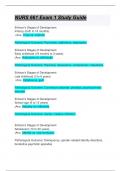Exam (elaborations)
Bsci 170 Final Practice Questions
- Course
- BSCI 170
- Institution
- University Of Maryland - College Park
This is a comprehensive and detailed practice material that contains questions from Exam 1-4 ,here to aid you in effective final exam prep. *Essential Study Material!! *For you, at a price that's fair enough!!
[Show more]






